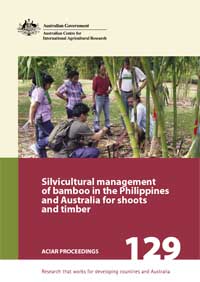- HomeHome
-
About ACIAR
- Our work
- Our people
-
Corporate information
- ACIAR Audit Committee
- Commission for International Agricultural Research
- Policy Advisory Council
- Agency reviews
- Executive remuneration disclosure
- Freedom of information (FOI)
- Gifts and benefits register
- Information publication scheme
- List of new agency files
- Contracts
- Legal services expenditure
- Privacy impact assessment register
- Commonwealth Child Safe Framework
- Benefits to Australia
- Careers
- 40 years of ACIAR
-
What we do
- Programs
- Cross-cutting areas
- Resources
- Where we work
-
Funding
- Research projects
- Fellowships
-
Scholarships
- John Allwright FellowshipScholarships to study in Australia for ACIAR partner country scientists to have Australian postgraduate qualifications
- ACIAR Pacific Agriculture Scholarships and Support and Climate Resilience Program
- Alumni Research Support Facility
- Publications
- News and Outreach
Proceedings
Silvicultural management of bamboo in the Philippines and Australia for shoots and timber
Date released
22 March 2009
Publication Code
PR129
Overview
There is a push at the national and international levels to (re)introduce perennial species into cropping and ‘at-risk’ lands, capitalising upon their ecosystem service properties of containing soil and water erosion, protecting soil carbon reserves and sequestering atmospheric carbon dioxide on a real-time basis. Bamboo is one such species. It has extensive social and economic importance in Asia, and it is gaining ground in Africa and Latin America. In Australia, it was introduced over the past 20 years as a potential plantation species, principally for bamboo shoots but also for timber, while in the Philippines, bamboo culms (poles) are a poor-person’s resource at the household level, and it is also commercially exploited. ACIAR funded research in Australia and the Philippines aimed to identify production practices that lead to sustainable harvesting of shoots and/or culms from newly established or old and degenerated stands of bamboo. Co-sponsored by the Philippine Council for Agriculture, Forestry and Natural Resources Research and Development (PCARRD), a symposium was organised in November 2006 in the Philippines, to provide an opportunity for researchers to present their findings. The peer-reviewed papers contained herein provide an opportunity to fully report on the research. They will act as a valuable resource for people interested in the sustainable production and use of bamboo.




